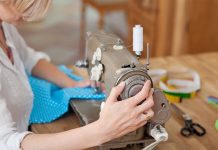Sewing machine oil is used for the lubrication of all types of sewing machines and models. Used correctly, this can enhance the performance and shelf life of both home use and industrial sewing machines. Traditionally, sewing machine oil was created from common lubricants, such as petroleum products, but a variety of other sewing machines oil alternatives both artificial and natural are available, created from common sources such as coconut oil. In this article, we’ll explore all you need to know about oil for sewing machines, sewing machine oil alternatives and most importantly, how to oil a sewing machine at home. We’ll also provide some general tips on ingredients you can use, machine lubrication in general and sewing machine maintenance.
Sewing Machine Oil Ingredients:

Petroleum Products:
Traditionally, all sewing machine oil ingredients came from a product derived from petroleum, lubricants referred to as petrochemicals. These natural lubricants are composed of minerals and ingredients found in crude oil, specifically petroleum. Used widely as industrial lubricants, these chemicals are used widely throughout the industry and in the home, however excessive exposure to these products has been deemed inadvisable. If using such lubricants as a source of sewing machine oil, be sure to avoid contact with the skin and eyes.
Natural sewing machine oil alternatives:
A variety of natural, safe and domestic lubricants can be used as effective sewing machine oils. Products such as olive, coconut and silicone oils that are normally found in the kitchen can be used individually or blended to create an alternative lubricant suitable for your own sewing machine oil ingredients. These oils are natural and relatively inexpensive, so feel free to experiment by using different measures of each to see how your own sewing machine responds to them. A good place to start is to use a small amount of each ingredient, introducing it to your sewing machine when lubricating to ensure that they do not cause any unwanted effects. By only using a small amount of natural sewing machine oil at a time you will protect your sewing machine from any damage.
Oil for industrial sewing machines:

The ingredients for industrial sewing machine oils are similar in their chemistry to the lubricants used for home sewing machines, however many of them contain heavy minerals and other harsh ingredients that are dangerous to humans and the environment. Many industrial lubricants and oils contain ingredients such as Teflon, paraffin and other harsh chemicals and shouldn’t be used in the home.
How to Oil a Sewing Machine
Before you start the oiling process, it’s important to make sure you have researched the ingredients you are using as a sewing machine oil as well as all the steps necessary to prepare the machine for lubrication. This includes cleaning, the tools and equipment needed and any additional parts/ spares you may need. Always make sure to consult the user manual for your sewing machine as many models have their own unique settings and warnings. If you don’t have your sewing machine manual you can usually find these online by checking out the manufacturer’s website or by searching the model make and model.
Gather the right tools

- For cleaning, try using soft fabrics, dust cleaners and stiff brushes like lint brushes or toothbrushes. You want to make sure that you can reach small spaces within the sewing machine without damaging it. Cleaning is an important step to take before lubricating the inside of the machine with sewing machine oil.
- For repairs, make sure you only use spare parts that are suitable for your sewing machine model or manufacturer.
- For lubrication, whichever ingredients or products you are using for sewing machine oil
- For additional tools, try using compressed air to “spray away” difficult-to-reach dirt and lint.
Clean the machine

- Before starting, ensure that all additional machine parts and materials are removed to prevent them from getting in the way. Excess thread, the stitching plate, needles and hooks should be removed, ensuring the machine is disconnected from a power source.
- Using compressed air, blow away dust and lint from inside the machine. It’s important that small pieces of dirt and debris are removed before lubrication, as this will mix with sewing machine oil and remain behind. When using compressed air, hold the can at a distance of around 6 inches/15 cm from the components you are cleaning, at a shallow angle that will blow dirt away from the machine as opposed to deeper within it.
- Using a piece of soft fabric or dust cloth, clean the larger surfaces and spaces in the machine. You may want to use a damp cloth to tackle hard-to-remove dirt, ensuring that the sewing machine and parts are dried afterward.
Lubrication and oiling

- When applying any of your sewing machine oil ingredients, such as coconut oil, only use a few drops at a time. Excessive amounts of oil can make it difficult to clean and can slow actually slow down components on the inside of the sewing machine.
- Put a few drops of oil into all the moving sewing machine parts. If you are unsure about whether a sewing machine component requires lubrication, simply consider if it rubs against another part when the machine is operational.
- If you use too much oil, use a dry cloth to rub away the excess carefully and gently.
- Put a few drops of oil inside the hook race of the sewing machine in order to oil the shuttle hook. This is the ring area that allows the bobbin hook to fit into place, so by ensuring its lubrication the small parts will not rub together and wear the machine.
- When oiling each individual part, it’s important to manually move them once the lubrication has been applied to ensure the oil is evenly spread and distributed.
Tips
- If at any stage you are unsure how to oil a sewing machine or your model in particular, always follow the manufacturer’s guide on lubrication, cleaning or repairs. If your model manual states that the machine does not require sewing machine oil then you do not need to perform any lubrication.
- Only disassemble a small part of your sewing machine at a time. This prevents the process becoming overcomplicated or running the risk of breaking/losing machine parts
- It’s important to regularly clean, wipe and lubricate your sewing machine in order to ensure it’s continued performance.

Warnings
- Throughout the cleaning and lubrication process, ensure the sewing machine is disconnected from a power source, to prevent injury when working on moving parts and needles.
- Although a variety of natural and mineral based lubricants will work as sewing machine oil ingredients, it’s important to check when considering other common alternatives. For example, car oil and WD40 are not suitable for use.
Conclusion
It should now be clear that sewing machine oils come from a variety of natural ingredients, lubricants, and minerals. How to clean a sewing machine is completely dependent on the machine’s age and designed purpose, as well as your personal preference to use custom-made sewing machine oil or a natural alternative. Regular oiling is important to ensure a sewing machine’s performance and longevity. When cleaning or oiling your own sewing machine and other essential tools for dressmakers, it is best to follow the model manual, avoid industrial or dangerous chemicals and use your own common sense when applying tools and oils to machine parts.
 Home
Home Sewing, Embroidery & Serger
Sewing, Embroidery & Serger Cutting machines
Cutting machines Brands
Brands Review
Review






































